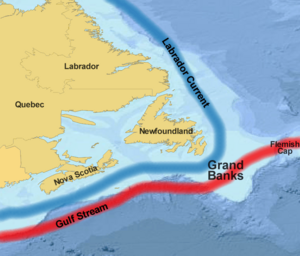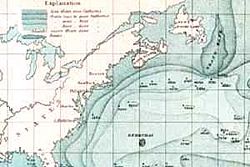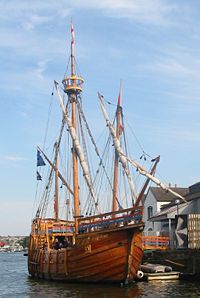Difference between revisions of "Grand Banks" - New World Encyclopedia
Mary Anglin (talk | contribs) m (→History) |
Mary Anglin (talk | contribs) m (→History) |
||
| Line 25: | Line 25: | ||
However, it was not until John Cabot noted their fabulous abundance that the existence of these fishing grounds became widely known in [[Europe]]. Soon, fishers and merchants from [[France]], [[Spain]], [[Portugal]] and [[England]] developed seasonal inshore fisheries producing for southern European markets. | However, it was not until John Cabot noted their fabulous abundance that the existence of these fishing grounds became widely known in [[Europe]]. Soon, fishers and merchants from [[France]], [[Spain]], [[Portugal]] and [[England]] developed seasonal inshore fisheries producing for southern European markets. | ||
| − | Known as "dry" fishery, [[cod]] were split, salted, and dried on shore over the summer before crews returned to Europe. The French pioneered "wet" or "green" fishery on the Banks proper around 1550, heavily salting the cod on board and immediately returning home. Within twenty years of that, hundreds of vessels and thousands of men were active in the two fisheries | + | Known as "dry" fishery, [[cod]] were split, salted, and dried on shore over the summer before crews returned to Europe. The French pioneered "wet" or "green" fishery on the Banks proper around 1550, heavily salting the cod on board and immediately returning home. Within twenty years of that, hundreds of vessels and thousands of men were active in the two fisheries. |
| + | By the seventeenth century, French and English fishermen began to spend winters in Newfoundland. Though French residents were forced to leave the island in the 1700s, French migrant fishery continued on the northern part of the island. [[English language|English]]-speaking Newfoundlanders had largely replaced English migrant fishers inshore by around 1815. Soon these fish stocks became important for the early economies of eastern [[Canada]] and [[New England]]. Schooners based in New England and Newfoundland began to make inroads on the Europeans vessels' share of the catch. By the end of the century, European ships fishing the Grand Banks were largely French, while Brazil and the Caribbean became major markets. | ||
| + | On November 18, 1929, a major [[earthquake]] (known as the 1929 Grand Banks earthquake) on the southwestern part of the Grand Banks bordering the [[Laurentian Channel]] caused an underwater landslide which resulted in extensive damage to [[transatlantic cable]]s and generated a rare Atlantic [[tsunami]] that struck the south coast of [[Newfoundland]] and eastern [[Cape Breton Island]] claiming 27 lives in the [[Burin Peninsula]]. | ||
| + | |||
| + | ===Disputes=== | ||
| + | Possibly the world's most important international fishing area, | ||
| + | Technological advances in fishing such as large factory ships and [[sonar]], as well as geopolitical disputes over [[territorial sea]] and [[exclusive economic zone]] (EEZ) boundaries, have led to [[overfishing]] and a serious decline in the fish stocks of the Grand Banks from around 1990. | ||
| − | + | Fishery-based economy of [[Newfoundland and Labrador]] is in a severe crisis from 1990s. Canada's EEZ currently occupies the majority of the Grand Banks except for the lucrative "nose" (eastern extremity, near the [[Flemish Cap]]) and "tail" (southern extremity) of the fishing bank. However, the [[Treaty of Paris (1783)]] gives the [[United States]] shared rights to fish these waters, despite the EEZ. | |
| − | |||
| − | |||
REWORD: | REWORD: | ||
The Grand Banks were probably the world's most important international fishing ground until 1977, when Canada extended its offshore jurisdiction to include most of the area. Many of the commercial species, however, were overfished and depleted by the early 1990s. Oil drilling began on the banks in the late 1970s, but was slowed after the loss of the Ocean Ranger rig on Feb. 15, 1982. | The Grand Banks were probably the world's most important international fishing ground until 1977, when Canada extended its offshore jurisdiction to include most of the area. Many of the commercial species, however, were overfished and depleted by the early 1990s. Oil drilling began on the banks in the late 1970s, but was slowed after the loss of the Ocean Ranger rig on Feb. 15, 1982. | ||
| + | |||
| + | |||
| + | |||
| + | But it was no doubt twentieth-century technology, especially the voracious factory-freezer ship introduced in the 1950s, that put it at risk. Europeans, some of them from as far away as Russia, returned in force to the Banks and even inshore in the post–World War II period, catching unprecedented quantities of an already dwindling fish stock. Catches of cod peaked in the late 1960s. Experts continue to weigh the long-term effects of climatic change on cod populations, but they now agree that overfishing was the primary factor in the decline of the inshore and Banks fisheries. International fisheries organizations and even the Canadian government, which imposed a two-hundred-mile management zone covering most of the Grand Banks in 1977, were slow to act decisively to conserve the resource. By 1992, the stock was so depleted that Canada was forced to close its Grand Banks fishery, putting thousands out of work. Reopened in the late 1990s, the cod fishery operates in the early twenty-first century on a severely reduced scale. Recovery, if it happens at all, will take decades. Meanwhile, in 1997, a consortium of companies began tapping another of the Banks' riches, the vast Hibernia oil field, discovered in 1979. | ||
==Research== | ==Research== | ||
Revision as of 05:20, 8 August 2008
The Grand Banks is a large area of submerged highlands southeast of Newfoundland and east of the Laurentian Channel on the North American continental shelf.
Covering 36,000 square miles (93,200 sq km), the Banks are relatively shallow, ranging from 80 to 330 feet (25 to 100 meters) in depth. In this area, the cold Labrador Current mixes with the warm waters of the Gulf Stream. The mixing of these waters and the shape of the ocean bottom lifts nutrients to the surface. These conditions created one of the richest fishing grounds in the world.
Character
Extensive marine life flourishes in the Grand Banks both on or near the bottom, as well as in the water column, due in part to its relative shallowness. Its extensive range provides important spawning, nursery and feeding areas to a large number of fish and shellfish species, whose natural range extends beyond the exclusive economic zone and into international waters. This has made it an important part of the Canadian and the high seas fisheries.
Fish species include Atlantic cod, haddock, capelin, Atlantic halibut, redfish (ocean perch), Greenland halibut (turbot), yellowtail, witch flounder, and American plaice (a flatfish). Crustaceans include crab, lobster, scallop, and shrimp.
The area also supports large colonies of sea birds such as Northern Gannets, shearwaters and sea ducks and various sea mammals such as seals, dolphins and whales.
The meeting of the cold Labrador Current and the warm Gulf Stream in this vicinity causes heavy fogs. Coupled with hazardous icebergs and the nearby transatlantic shipping lanes, fishing in the Grand Banks is hazardous.
History
The Beothuk, the aboriginal inhabitants of the island of Newfoundland at the time of European contact in the 15th and 16th centuries, were not known to have fished the Grand Banks.
While the area's "official" discovery is credited to John Cabot in 1497, English and Portuguese vessels are known to have sought out these waters prior to that, based upon information dating from earlier Viking voyages to Newfoundland. Several navigators, including Basque fishermen, are known to have fished these waters in the 15th century. In the 15th century some texts refer to a land called Bacalao, the land of the codfish, which is possibly Newfoundland.
However, it was not until John Cabot noted their fabulous abundance that the existence of these fishing grounds became widely known in Europe. Soon, fishers and merchants from France, Spain, Portugal and England developed seasonal inshore fisheries producing for southern European markets.
Known as "dry" fishery, cod were split, salted, and dried on shore over the summer before crews returned to Europe. The French pioneered "wet" or "green" fishery on the Banks proper around 1550, heavily salting the cod on board and immediately returning home. Within twenty years of that, hundreds of vessels and thousands of men were active in the two fisheries.
By the seventeenth century, French and English fishermen began to spend winters in Newfoundland. Though French residents were forced to leave the island in the 1700s, French migrant fishery continued on the northern part of the island. English-speaking Newfoundlanders had largely replaced English migrant fishers inshore by around 1815. Soon these fish stocks became important for the early economies of eastern Canada and New England. Schooners based in New England and Newfoundland began to make inroads on the Europeans vessels' share of the catch. By the end of the century, European ships fishing the Grand Banks were largely French, while Brazil and the Caribbean became major markets.
On November 18, 1929, a major earthquake (known as the 1929 Grand Banks earthquake) on the southwestern part of the Grand Banks bordering the Laurentian Channel caused an underwater landslide which resulted in extensive damage to transatlantic cables and generated a rare Atlantic tsunami that struck the south coast of Newfoundland and eastern Cape Breton Island claiming 27 lives in the Burin Peninsula.
Disputes
Possibly the world's most important international fishing area,
Technological advances in fishing such as large factory ships and sonar, as well as geopolitical disputes over territorial sea and exclusive economic zone (EEZ) boundaries, have led to overfishing and a serious decline in the fish stocks of the Grand Banks from around 1990.
Fishery-based economy of Newfoundland and Labrador is in a severe crisis from 1990s. Canada's EEZ currently occupies the majority of the Grand Banks except for the lucrative "nose" (eastern extremity, near the Flemish Cap) and "tail" (southern extremity) of the fishing bank. However, the Treaty of Paris (1783) gives the United States shared rights to fish these waters, despite the EEZ.
REWORD: The Grand Banks were probably the world's most important international fishing ground until 1977, when Canada extended its offshore jurisdiction to include most of the area. Many of the commercial species, however, were overfished and depleted by the early 1990s. Oil drilling began on the banks in the late 1970s, but was slowed after the loss of the Ocean Ranger rig on Feb. 15, 1982.
But it was no doubt twentieth-century technology, especially the voracious factory-freezer ship introduced in the 1950s, that put it at risk. Europeans, some of them from as far away as Russia, returned in force to the Banks and even inshore in the post–World War II period, catching unprecedented quantities of an already dwindling fish stock. Catches of cod peaked in the late 1960s. Experts continue to weigh the long-term effects of climatic change on cod populations, but they now agree that overfishing was the primary factor in the decline of the inshore and Banks fisheries. International fisheries organizations and even the Canadian government, which imposed a two-hundred-mile management zone covering most of the Grand Banks in 1977, were slow to act decisively to conserve the resource. By 1992, the stock was so depleted that Canada was forced to close its Grand Banks fishery, putting thousands out of work. Reopened in the late 1990s, the cod fishery operates in the early twenty-first century on a severely reduced scale. Recovery, if it happens at all, will take decades. Meanwhile, in 1997, a consortium of companies began tapping another of the Banks' riches, the vast Hibernia oil field, discovered in 1979.
Research
Canada is currently performing the hydrographic and geological surveys necessary for claiming the entire continental shelf off eastern Canada, under the auspices of the latest United Nations Convention on the Law of the Sea. Once this aspect of UNCLOS is ratified, Canada will presumably control these remaining parts of Grand Banks which are outside of its EEZ jurisdiction.
Petroleum reserves have also been discovered and a number of oil fields are under development in this region, most notably the Hibernia, Terra Nova, and White Rose projects; the harsh environment on the Grand Banks also led to the Ocean Ranger disaster.
Semi-fictional depictions of fishermen working on the Grand Banks can be found in Sebastian Junger's novel The Perfect Storm (1997) and in Rudyard Kipling's novel Captains Courageous (1897).
ReferencesISBN links support NWE through referral fees
- Answers Corporation. Grand Banks Retrieved June 6, 2008.
- Bradley, W. P. (1969). They live by the wind; the lore and romance of the last sailing workboats: the Grand Banks schooners, the square-rigged training ships, the Chesapeake oysterboats, the fishing sloops of the Bahamas. New York: Knopf.
- Greenpeace. History of the Grand Banks Cod Fishery Retrieved June 6, 2008.
- Hiscott, Richard N., and Andrew J. Pulham. 2005. Petroleum resources and reservoirs of the Grand Banks, eastern Canadian margin. Geological Association of Canada special paper, 43. St. John's, N.L.: Geological Association of Canada. ISBN 9780919216822
- Kurlansky, Mark. 1997. Cod: a biography of the fish that changed the world. New York: Walker and Co. ISBN 9780802713261
- The Columbia Gazetteer of North America. Grand Banks Retrieved June 6, 2008.
External links
All Links Retrieved June 6, 2008.
- Overfishing:The Grand Banks and the Flemish Cap
- Government response to the standing committee on fisheries and oceans' tenth report
Credits
New World Encyclopedia writers and editors rewrote and completed the Wikipedia article in accordance with New World Encyclopedia standards. This article abides by terms of the Creative Commons CC-by-sa 3.0 License (CC-by-sa), which may be used and disseminated with proper attribution. Credit is due under the terms of this license that can reference both the New World Encyclopedia contributors and the selfless volunteer contributors of the Wikimedia Foundation. To cite this article click here for a list of acceptable citing formats.The history of earlier contributions by wikipedians is accessible to researchers here:
The history of this article since it was imported to New World Encyclopedia:
Note: Some restrictions may apply to use of individual images which are separately licensed.


